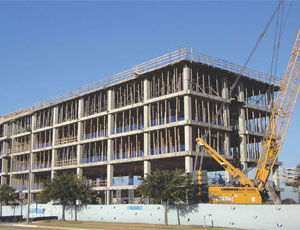... and 2013. They include a $50-million building renovation and expansion at Ivy Tech Community College, a $475-million tower at Riley Hospital for Children and a $754-million facility at Wishard Memorial Hospital. Two federal buildings are undergoing a $105-million renovation.

Development of the convention complex continues, with a $275-million expansion of the Indianapolis Convention Center. A 1,600-room Marriott hotel is going up and other nearby hotels are undergoing renovation and updating.
“I know the contractors are not as busy as they’d like to be, but we’re lucky,” says Sweeney. “We’ve had a decent pipeline, and hopefully these projects will help people ride out the rough time here.”
CHICAGO: Chicago, including Naperville and Joliet, was down in all major categories and overall. Total values were down 52%, from $18.3 billion in 2008 to $8.8 billion in 2009. Non-building construction was down 5%, from $3.5 billion in 2008 to $3.4 billion in 2009. Non-residential building starts were down 69%, from $11.2 billion in 2008 to $3.4 billion in 2009.
In contrast, triple-digit gains were found in dams and reservoirs, up 628%; capitals/courthouses/city halls, up 138%; and airports (excluding buildings), up 397%.
“We’re not setting the world on fire, but we’re doing okay,” says Richard Tilghman, senior vice president for Pepper Construction Group in Chicago.
Pepper’s healthcare practice is strong, and the company recently picked up two large federal building projects from U.S. General Services Administration. Pepper also is on the construction management teams for both Wishard in Indianapolis and the art museum in St. Louis.
“It all helps with stability from an employment standpoint, but profitability is hard to achieve,” he says. “The profits we’re stuck with now are pretty skimpy.”
“From my perspective, it’s more a matter of funding than project type,” says Mike Bohn, senior vice president for Gilbane Building Co. in Chicago. “If you try to analyze by market sector, it’s difficult to make sense of it all. But if you look at how they got the money, you’ll see patterns emerge.”
He explains: Dormitories sometimes are built in partnership with a developer who operates the building or leases it back to the school. Public projects, aside from any stimulus money, may be funded because old debt was retired or voters authorized new debt.
“They’re not being funded out of operating budgets or sales tax revenues,” he says.
Bohn’s office is working largely on education, healthcare and corporate projects. It recently completed the expansions of the Will County Jail and Kendall County Courthouse.
MILWAUKEE: Milwaukee, including Wau-kesha and West Allis, saw a 33% decrease overall, from $2 billion in 2008 to $1.3 billion in 2009. Non-residential building was down 59%, from $1.1 billion in 2008 to $457 million in 2009. But non-building construction soared 42%, from $332 million in 2008 to $471 million in 2009.
Subcategories that did well were airports (excluding buildings), up 1398%; dormitories, up 309%; and capitals/courthouses/city halls, up 573% .
One current project is the six-year, statewide $6-billion highway improvement program, which began in 2008. The first phase, the Marquette Interchange, is finished. The second phase, I-94 from Milwaukee to Illinois, is under way.
The four-year, $59-million runway safety area improvement project at General Mitchell International Airport began last year. A separate residential sound mitigation project is planned.
“There’s no question the stimulus is offering a lifeline, but it’s still going to be a tough year,” says Pat Goss, executive director of the Wisconsin Transportation Builders Association in Madison, Wis. “The average contractor we represent, between 40% and 60% of what they do in a normal year is not state work.”
“Our brightest news is universities in general,” says Tom Kennedy, vice president and general manager for Opus North in Milwaukee. “That sector is 10 times more robust than anything we are currently seeing. We are doing a lot of classrooms and administration buildings—three at Marquette University right now. We’re also talking in Indiana and pursuing two or three other campuses in the Midwest.”
Private universities seem to have a little more control over how and when they spend their money than public ones, he says.
Opus North also is developing The Shoppes at Fox River, a 500,000-sq-ft shopping center in Waukesha.
“Retail is ready to go because so many projects were put on ice,” says Kennedy.



Post a comment to this article
Report Abusive Comment